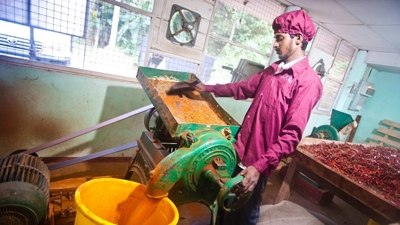New Opportunities
The emergence of Sri Lanka from the thirty-year long conflict brings new opportunities for the country’s economic growth and development. Sri Lanka has seen a steady economic growth over the past decade despite fragile macro-economic environment; the decades-old civil conflict; a large fiscal deficit, and challenges posed by the current global economic crisis.
However, during the height of the global economic crisis the overall GDP growth between 2008 and 2009 declined from 6 percent to 3.5 percent. Exports were the main channel through which the crisis hit Sri Lanka.
Still the country has managed to halve the national poverty headcount ratio in the last 5 years. But it remains relatively high at 15.2%. Growth and poverty reduction outside the Western province still face obstacles due to inadequate infrastructure, particularly in rural areas; the stagnant agricultural sector; access to credit and lack of skilled labor force.
Small and Medium Enterprises
According to Cecile Niang, Economist with South Asia Finance & Private Sector Development, “One of the main lessons learned in post conflict countries is that the creation of employment opportunities is critical for faster recovery.”
The global economic crisis affected the Small and Medium Enterprises (SMEs) sector the most. According to estimates of the Sri Lanka Industry Survey of 2008, there are over 18,000 companies operating in the country of which about 91% are small and medium enterprises.
A vibrant SMEs sector can play a key role in creating jobs and high economic growth. Achieving and sustaining such growth and higher employment will require a boost in industrial and services growth, spurred by SMEs.
“Yet, several factors constrain the growth and competitiveness of Sri Lanka’s SMEs,” said Niang. The lack of access to adequate and timely financing is especially critical. “Without it, borrowing becomes more expensive and profit margins are reduced, holding back the establishment of new units and the consequent increase in job creation.”
National Strategy and World Bank Role
In early 2010, The Government of Sri Lanka announced a National Strategy for SME Sector Development that called for a significant array of programs aimed at making SMEs more competitive, more efficient by applying modern technology to improve production processes, and more effective exporters.
The World Bank recently approved a $57.4 million credit for strengthening access to finance for Sri Lankan SMEs. The Project supports the Sri Lanka Government’s efforts to improve access to finance for SMEs affected by the global economic Crisis. Funded under the Pilot Crisis Response Facility, the project consists of two components.
Project Components
The first is the Financing and Risk Sharing Facility component. It includes a Line of credit to participating state and private commercial banks to refinance SME loans and a risk sharing facility providing partial credit guarantees to reduce the banks’ risk of lending to SME borrowers.
The second component focuses on policy and capacity enhancement for SME banking. Technical assistance to support banks in developing their SME banking capabilities will be provided.
The project includes support to identify measures to create a more enabling environment for SME banking.
“The project aims to incentivize banks to provide credit to SMEs while building their SME lending capability over time,” said Niang. “The banks can independently access the line of credit or risk sharing facility, but the success of the facilities will depend on the application of modern SME lending technologies and risk management procedures.”

